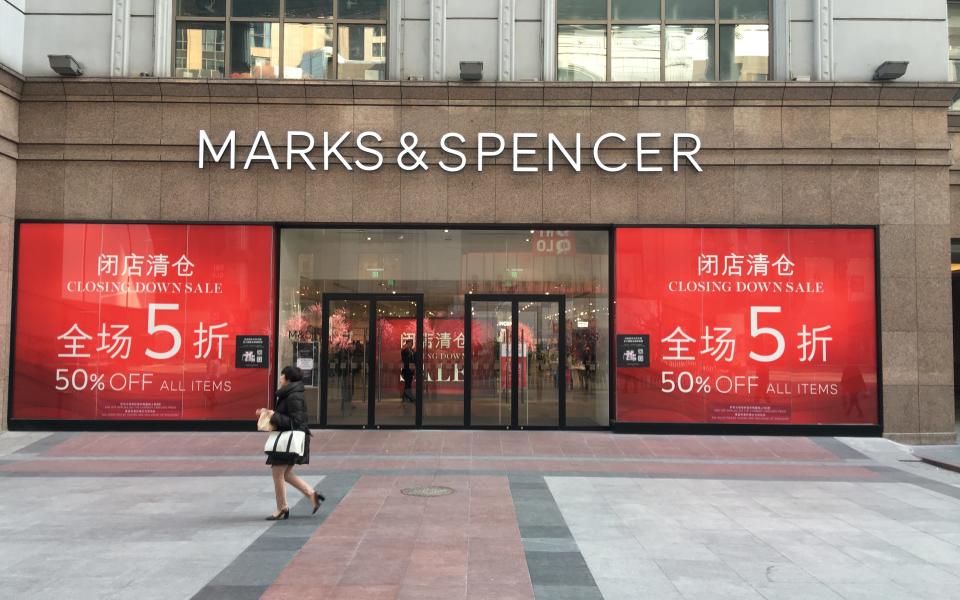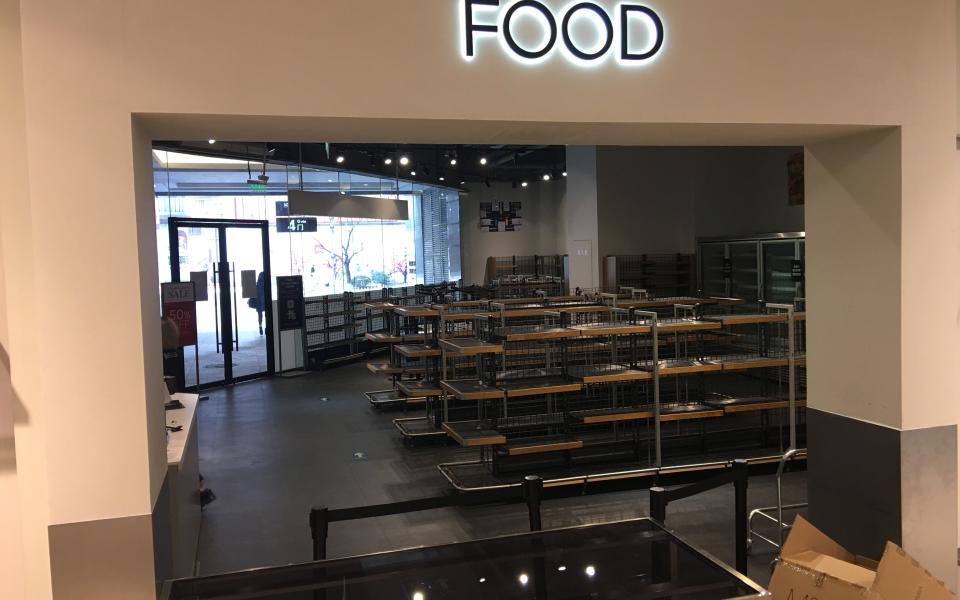Marks and Spencer pulls out of China's high street - the world's biggest retail market
With a rapidly growing middle class living in constant fear of shoddy counterfeit clothing and a perpetual cycle of food scares, China appears – on the surface at least – to be the perfect match for Marks and Spencer’s brand of trusted quality.
But barely a year after bosses expressed positivity as they opened their tenth store, the British retailer is pulling out of the Chinese high street this month.
If it was a snug fit executives were looking for, they should have invested in a pair of M&S Collection cashmere rich socks.
The exit is swift, and deeply upsetting for British expats in China – particularly in Beijing where choices are limited for good quality imported food.
But for the local Chinese population, news that the capital’s only outlet was shutting and selling its remaining stock with huge discounts was met with a collective: “Great!.....But what is Marks and Spencer?”
The sight of queues of shoppers waiting for an up to an hour to buy dozens of bottles of wine during those final few days must have been harrowing for the store management.
“I’d have paid the regular price for a bottle of this,” said one customer, surnamed Cheng, who was navigating 36 bottles of Rioja through a throng of other shoppers.
“But I never knew this place existed,” added the 30-year-old, who said he earned about £50,000 a year as a manager in an IT company.
It is this type of high-earning consumer that could have helped save Marks and Spencer in China if they had known of the store earlier – and came in their numbers.
Adam Colton, Managing Director of Greater China, pointed to “low brand awareness” as a key reason for the China exit.
“Growth in market share is also challenging given the nature of the market,” Mr Colton added.
But China’s retail market was said to have eclipsed the US to become the world’s biggest last year.
Its total value was $4.89 trillion (£3.98 trillion), compared with $4.82 trillion (£3.92 trillion) in the US, according to the latest worldwide retail forecast by eMarketer.
Less than a fifth of that total was Internet sales, the New York-based research firm said.
So if consumers are still buying products on the Chinese High Street, maybe Marks and Spencer’s problems ran deeper?
Was the brand’s stodgy ultra-British reputation putting off consumers? Particularly younger Chinese who favour far edgier clothing.
That conclusion seems difficult to reach, given the Chinese are curiously attracted to the more traditional elements of ‘Britishness’.
The local branches of Dulwich and Harrow schools remain popular among parents, the young enjoy Harry Potter and Sherlock DVDs, while imported British vehicles, such as Bentleys or Jaguars, are often spotted on the streets of Beijing or Shanghai.
But Jim James, a Beijing expat since 2006 and the managing director of Morgan Cars China, said despite the popularity of British brands, companies seeking a slice of the market still have their work cut out.
“The Chinese love British goods, but Chinese consumers are discerning,” he said. “Being British gives brands a head start in certain categories, but it does not guarantee winning the race.”
Chinese pundits point to a number of factors behind the failure of Marks and Spencer on the domestic high street.
Among the biggest challenge is one that faces all Chinese retailers – sky high rents. Indeed, Marks and Spencer – as one would expect – located its stores in the costliest retail districts, particularly in Shanghai.
These multi-storey department stores looked impressive from the outside, but Chinese consumers traditionally favour smaller stores – or at least they wouldn’t make the effort to walk through four storeys to buy a packet of imported biscuits.
Marks and Spencer has also been accused of opening stores in odd places – either in second tier cities, or near to well-established, cheaper foreign rivals, Chinese observers said.
“One can understand Marks and Spencer needing a presence in first tier cities such as Beijing and Shanghai, but elsewhere in China, I don’t think people are going to spend a lot of money on things like dresses, which they can find in a nearby store at a far cheaper price” said Yang Dazhong, a retail expert from Zhongtian Yuanguang consultancy in Beijing.
Mr Yang questioned the retailer opening stores in the northern port city of Qingdao, or Changzhou and Suzhou, in the eastern Jiangsu province.
But possibly the greatest barrier Marks and Spencer faced in China was a lack of understanding of the Chinese consumer.
“I don’t think Marks and Spencer understood China very well,” added Mr Yang. “It clearly had no clear idea what type of consumer it was targeting.”
A commentary in the Jiangsu Business News went further: “The problem is not just that they know little about China, but that they never bothered to learn.”
Among the issues highlighted by the newspaper was that the English names of products were poorly translated into Chinese.
Also, most of the clothes used British and European sizes, without saying in Chinese whether they were small, medium and large.
Other pundits pointed to Marks and Spencer failing to sell clothing that fitted the Chinese body shape, which experts say is generally smaller.
Zhou Changqing, the chief executive of the Dataquest consultancy, which compiles statistics to domestic retailers, said Marks and Spencer failed to get Chinese people to “take their brand to heart” as they did not engage them properly.
“I have been to Marks and Spencer in London and you could tell they have a very stable market of middle class consumers in the UK which they know very well,” he said.
“But in China, they have focused too broadly on consumers at every social level, without really targeting anyone in particular,” he said.
“You just have to compare this to Ikea, who rapidly change their marketing strategy to meet their ideal market in China,” he added. “Chinese people love Ikea. They spend a day out at their stores - and even have a sleep!”
Indeed, a recent study by Bain & Co said foreign retailers have been losing market share to their local rivals in recent years – largely because they quickly lose sight of fast-changing consumer demands in China.
In 26 areas studied by the consultancy, foreign brands’ sales shrank 1.4 percent in 2015, while for local brands, it grew by 7.8 percent.
Domestic firms have advantages in having “a single-country-focused development process for new products,” the study said.
“(They) can quickly respond to what Chinese consumers want.”
Marks and Spencer has, however, been boosting its profile on the Chinese Internet, and bosses believe China’s thirst for shopping on their mobile phones could still provide opportunities going forward.
It launched on Alibaba’s online marketplace Tmall in 2012 and enjoyed double-digit growth on last year’s ‘Singles Day’, an online shopping bonanza held on November 11 which is compared to Black Friday in the US.
Chinese shoppers spend three hours a day on digital media, and rapid and cheap delivery of goods has created a booming e-commerce sector.
Marks and Spencer online presence brings little comfort to expats, as the retreat from the high street means the end of its sales of food and wine in China.
Bosses may reject over analysing the company’s withdrawal from China, given it is part of a global strategy which will see the closure of 53 wholly-owned stores in France, Belgium, Estonia, Hungary, Lithuania, the Netherlands, Poland, Romania and Slovakia.
But as they see the world’s biggest market slip through their fingers, they may lament in sorrow one of their more memorable marketing campaigns: ‘This is not just an exit. This is a China exit.’
Additional reporting by Christine Wei

 Yahoo Finance
Yahoo Finance 









